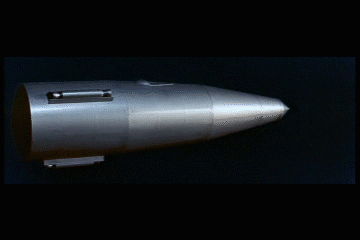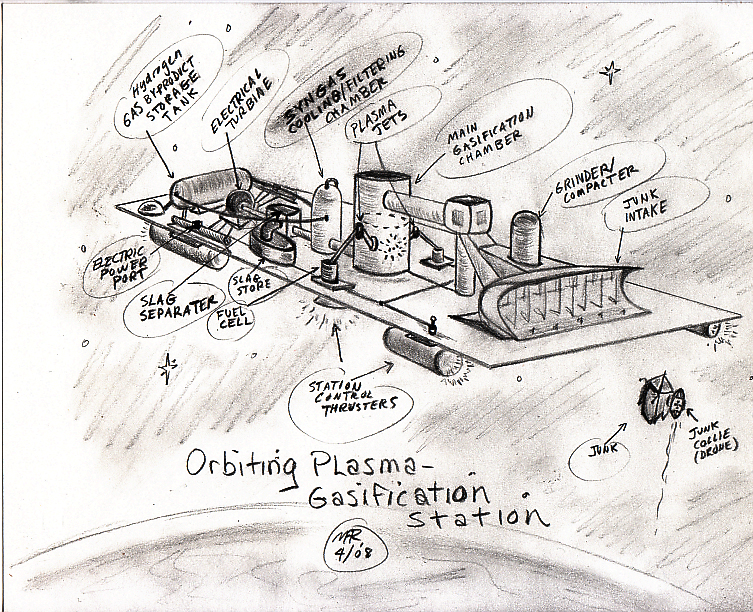THE
SPACE JUNK REMEDIATION PROJECT
Michael Ricciardi
The following design document was the result of a thought experiment on
remediation of orbital debris, i.e., ‘space junk’. The author/designer is a non-specialist or engineer, but is a naturalist, science scholar, and tech.-art designer.
A
GENERAL METHODOLOGY
for Larger Objects (≥ 10 cm)
i)
Capture
ii) Contain (secure for disposal or
redeployment)
iii) Re-Deploy (into deep space,
solar trajectory, or to
earth; de-orbit / re-orbit
iv)
Recover/Recycle (if re-
deployed to earth)
My first attempt at a concept design for
space junk removal was inspired by the
opening sequence in the James Bond film You Only Live Twice:
.................................

THE JUNK EATER
Multi-functional Utility
Craft for Controlled
Elimination of Debris
[MUCCED]

Problems: A dedicated, single space craft would
require great amounts of energy to intercept objects in different orbital
planes; junk size limitation? – Need to redeploy contained objects frequently - power source?.
Solutions:
Maneuver Junk Eater to different altitude
(taking advantage of differential precession of node lines) then return to
altitude of interest (N.L. Johnson); Nuclear (NERVA engine?) or plasma energy
source (on board) or Hydrogen fuel cells (or both); de-obit or re-orbit
objects (above LEO ?), thus limited need for containment (if redeployed to
Earth for analysis/recycling)
SOME ALTERNATIVE IDEAS:
The “Junk Collie”
-
Drone/robotic device attaches to junk, and, through remote control, shifts junk
into deep space/solar trajectory, or earth re-entry (if piece is wanted
for analysis or recycling). Also, drone could attach metallic ‘drag strip’,
or carbon mesh ‘sail’ (see OLDA concept design; laser targeting) to junk
to accelerate decay. (note: “current manned space craft cannot reach key
orbital regimes above 600km” – N. L. Johnson)

Problems:
Cost; energy requirements (source), propulsion
system, also: significant long-term power and altitude control subsystems; drone
needs space base (?)
Solutions:
Cost ≤ Military drones; ion engine,
or, solar-electric propulsion technology; lower energy system that “nudges”
junk incrementally into desired orbit (longer term) or decay trajectory
(reduces speed); docks at ISS; engineering challenge.
Orbital Laser Decay Accelerator
Dedicated,
space-based, omni-directional laser platform (in HEO; above 2000km) for
selective tracking, targeting, and heating of objects* to accelerate decay
(mimic ‘cleansing’ effect from high solar activity/ radiation pressure).
* Smaller objects under 10 cm or critical size

Problems:
Technical feasibility; DOD concept (SBL
system); large mass of satellites = large amount of energy needed to deposit on
object to effect orbital changes; laser ‘sail’ (C mesh) needed for large junk
(?); process may increase debris?
Solutions:
Use for smaller debris (lower energy needed
for altitude changes); joint gov./civilian usage; augment beam through
amplification ‘lensing’; use ‘pulsed capacitors’ for super efficient laser
pumping; use ‘junk collie’ drone to attach ‘sail’; realistic goal: reduce
altitude.
Plasma
Beam “Junk Blower” / OPRA
Similar function to Laser craft –
accelerates decay of debris; also: use as a junk ‘re-locator’, ala ‘leaf
blower’, to create temporary launch window (or altitude reduction).
Magnetized Plasma Beam (Mag-Beam) concept was conceived as a way of
accelerating space flight between distant planets (Winglee, UW); same concept
here (without the dual station plan; one plasma beam source for junk targeting).

Problems:
Technical
challenge; initial energy source; ‘beaming’ or re-locating space junk could
cause break ups / increased risk of collisions and thus total debris (and risk,
etc.)
Solution:
Highly
controlled targeting within debris ‘fields’;
combine solar-electric and H fuel cells; lower energy impact, i.e.,
‘nudging’ into reduced altitude band; possible complete decomposition of
object in orbit (size to energy per unit area dependent) Designer’s Note: if
it can be used for spacecraft transportation it can be used for space junk
re-location
OTHER STRATEGIES:
Electro-magnetic Debris Accumulator
•
Tethered
•
Interception for =
TIDĒ
•
Debris
•
Elimination

Problems:
Requires dedicated space craft; energy
source; disposal of debris post accumulation; non-magnetic particles (?)
Solutions:
Adapted to existing craft (?); tether can be
over a kilometer (or more) long, attached to space craft which retrieves
accumulator or maneuvers into desired LEO and lowers accumulator, ‘cuts’ EM
current, releasing debris into new altitude (use in conjunction with Junk Eater
?) ALTERNATIVE (for not magnetic metal/debris): Tethered sphere is coated with
a thick layer of AEROGEL (entire sphere could also be hollow and/or filled with aerogel;
sphere shell made of penetrable material to capture small, high velocity debris inside it.
LONG-TERM (BIG PROJECT) STRATEGY:
Orbital Plasma-Gasification Station
/ OPS
•
Maneuverable station (like the
ISS); advantages: Debris is ‘gasified’ in space (less risk of more
‘catastrophic’ collisions)
•
‘Syngas’ waste (H and CO) can
be converted into hydrogen (for fuel cells), methane, ethanol; gases and ‘glass
slag’ can be used on earth
•
OPS is ‘self-sustaining’, i.e.,
generates energy flow after ‘jolting’ (can be a ‘power station’ for other
spacecraft)

Problems:
COST! Also:
space installation, positioning, operation, maintenance
Solutions:
Long-term,
multi-national project; built in space (?); merely an engineering/management
problem…
The
Challenges of Junk Remediation
Technical Feasibility (includes energy
sources)
RESPONSE: Are we not a creative species (tech innovation/
invention)?
Economic Viability (viable=affordable
means: given other space programs and priorities)
RESPONSE: If we can spend trillions on warfare, can’t we spend 50
billion to build a dedicated space junk remediation system?
HOW MUCH RISK
IS ACCEPTABLE?
"The bottom line is very simple.''
Liou said. "Although the risk is small*, we need to pay attention to this
environmental problem.''
* Risk is “small” now, but will increase
over the next century, especially after 2055
IF WE DO
NOTHING…
Worst Case Scenario:
THE KESSLER EFFECT ? i.e., the space around
Earth becomes so riddled with junk that launchings are almost impossible.
Vehicles that entered space would quickly be destroyed.
More likely Scenario:
ECONOMIC BARRIER: more shielding = more
weight = more cost to launch => too expensive to do business in space
PROPOSAL:
Through a government and private sector
partnership: Implementation of a forty year plan to build an orbital,
maneuverable, space debris control station with multiple energy sources and
debris remediation strategies.
What is needed--vis a vis Space Junk
remediation--to maintain space activity and to insure a relatively safe
transition to a space-based culture and economy is…
Public Support (education), Political Will ($) & Technical Creativity
(‘steam’ = science-technology-engineering-art-mathematics)
Just as a SUPER FUND* was created for Earth industrial cleanup, so too,
we may need a ‘SUPER FUND’ for space industrial clean up.
* paid into from a space
tourism tax
"It's a
job that's never started that takes the longest to finish."
— J.R.R. Tolkien
Document & Designs created by
Michael A. Ricciardi